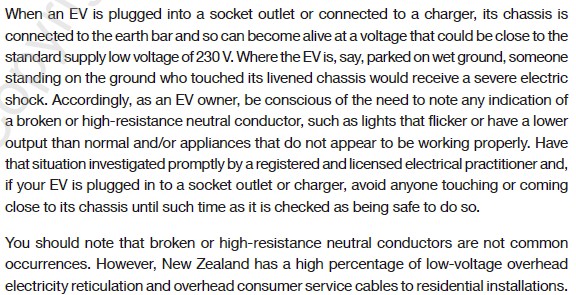Scott3:
Batman:
question - plugging my leaf 24kwh into the wall socket in this setup
leaf - OEM Audio cable - 30m 1.5mm2 extension - mitre10 RCD - wall socket
been doing that for half a year
is there any issue there?
cheers
It's bad practice.
Best practice is to use a fixed EVSE installed by an electrician as your main means of charging. ...
But of course many people, including myself have used a portable cable plugged to a wall outlet for an extended period. Works fine, but more area's of risk. (Domestic plug connection, cable between wall and brick has reduced protection, shared circuit etc).
Your config, does add even more risk:
- Adding what sounds like two additional plug/socket pairs triples the odds of an plug/socket pairing issue.
- 30m of cord, plus the plug parings will add up to fairly substantial voltage drop. - An online calculator showed a 30m run of 1.5mm^2 cable results in a 3.454% / 7.92V voltage drop. Add this to the drop from the RCD, plug / socket pairings, OEM audio evse etc, and we could well see a fairly low voltage at the car, but I don't think they are super sensitive to low voltage.
- 30m of extension cord increases the odds of something bad happening to it. Stored in a coil (extra heat generation), passed under something thermally insulation (carpet, matt, pile of leaves etc), mechanical damage.
- Risk of indoor rated components used outside.
The area around the EVSE would be my highest concern. Two plug connections (if it is a brick type), plus the RCD itself all in close proximity, generating heat...
I agree with Scott3's assessment. Using an extension lead on a mode-2 EVSE (aka IC-CPD, "charging cable", "granny charger") is bad practice, but you can mitigate the risks if you can't afford the expense & bother of getting a mode-3 charging station.
Here's what the manual supplied with my OEM Audio IC-CPD (a 6A/8A charger with a 10A AC plug, model 68A20B, OEM Shenqi Electronic https://evcharge.en.alibaba.com/ ) has to say in boldface about safety:

The plug on my OEM Audio - branded (Shenqi Electronic - manufactured) IC-CPD is a Nadway 56P310. This plug has no temperature sensor -- and it has no real need of one, because this IC-CPD is limited to 8A. The plug is rated IP66. If your IC-CPD also has a 10A plug with an orange IP66 twist-on cover, then you might consider engaging an electrician to install an outdoor 10A socket (such as an 56SO310 from Nadway or PDL) that's near enough to your vehicle that you don't have to use an extension lead.
There's another risk -- it occurs extremely rarely but it could be deadly, so it's important to know about when you're charging your EVs outdoors on a rainy day. Here's what SNZ has to say about this risk in SNZ PAS 6011 (published March 2021, available free-to-web at https://www.standards.govt.nz/shop/snz-pas-60112021/):


And... you're really not running a big risk with an 8A IC-CPD on an extension lead, so long as you monitor (at least occasionally) the temperature of the plugs & sockets. On a rainy day... even though my OEM Audio IC-CPD is rated IP-66, I'll have it tucked into a dry place on the ground underneath my vehicle, I'll avoid touching the chassis of my EV when the IC-CPD is plugged into it, I'll set up my charging circuit before applying mains power to it, and my last step in the setup will be to plug the IC-CPD into my EV; the first step in my tear-down will be to unplug the IC-CPD, then I'll turn off the mains power at the wall, and then I will dismantle my charging circuit (which may include an extension lead!).


.jpeg)
